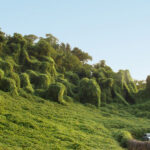The Kudzu Plant: A Fascinating Invasive Species
What do you mean by the Kudzu Plant?
The Kudzu plant, also known as Pueraria montana, is a fast-growing, invasive vine native to East Asia. It belongs to the pea family and was introduced to the United States in the late 19th century as a means of controlling soil erosion. However, it quickly spread out of control and is now considered one of the most problematic invasive species in the country.
How does the Kudzu Plant spread?

The Kudzu plant spreads rapidly through a combination of its rapid growth rate and ability to reproduce both vegetatively and by seed. Its vines can grow up to a foot per day, smothering native vegetation in its path. Additionally, it forms extensive root systems that can regenerate new plants from fragments of the parent plant, making it difficult to eradicate once established.
What is known about the Kudzu Plant?
One of the most infamous characteristics of the Kudzu plant is its ability to overtake and cover large areas of land. It has earned the nickname the vine that ate the South due to its aggressive growth habits in the southeastern United States. Its large leaves, which can measure up to seven inches across, provide shade that prevents sunlight from reaching native plants, effectively killing them off.
What is the solution to control the Kudzu Plant?
Controlling the spread of the Kudzu plant can be a challenging task, but there are several methods that have been proven effective. These include manual removal, herbicide treatments, prescribed burns, and the introduction of natural enemies such as insects or animals that feed on the plant. However, due to its resilient nature, long-term management strategies are often necessary to prevent regrowth.
Information about the Kudzu Plant
The Kudzu plant is not only a nuisance to native vegetation but also poses a threat to infrastructure such as buildings, roads, and power lines. Its rapid growth can cover structures and block sunlight, leading to decay and deterioration over time. In some cases, it has even been known to contribute to accidents and injuries by obstructing visibility or causing structural damage.
Despite its negative impacts, the Kudzu plant does have some beneficial uses. In traditional Chinese medicine, the plant’s roots have been used to treat various ailments, including alcoholism and high blood pressure. Additionally, its high nitrogen-fixing abilities make it a valuable resource for improving soil fertility and preventing erosion in certain agricultural settings.
Efforts to control the spread of the Kudzu plant have been ongoing for decades, with mixed success. While progress has been made in some areas through the implementation of integrated management plans, the plant continues to be a significant threat to ecosystems and biodiversity. Continued research and collaboration are necessary to develop more effective strategies for managing this invasive species.
Conclusion
In conclusion, the Kudzu plant is a fascinating yet problematic invasive species that has had far-reaching impacts on the environment and economy. Its rapid growth and ability to outcompete native vegetation make it a challenging adversary for land managers and conservationists. However, with ongoing efforts to control its spread and mitigate its effects, there is hope for preserving ecosystems and preventing further damage caused by this invasive vine.
FAQs about the Kudzu Plant
Q: Is the Kudzu plant harmful to humans?
A: While the Kudzu plant itself is not harmful to humans, its rapid growth can pose safety hazards by covering structures and obstructing visibility.
Q: Can the Kudzu plant be used for any beneficial purposes?
A: Yes, the Kudzu plant has traditional medicinal uses in Chinese medicine and can also improve soil fertility through nitrogen fixation.
Q: What methods are most effective for controlling the spread of the Kudzu plant?
A: Manual removal, herbicide treatments, prescribed burns, and biological control methods have all been used to manage the spread of the Kudzu plant.
Q: Why is the Kudzu plant considered an invasive species?
A: The Kudzu plant is considered invasive because it outcompetes native vegetation, disrupts ecosystems, and poses threats to infrastructure.
Q: What regions are most affected by the spread of the Kudzu plant?
A: The southeastern United States is particularly affected by the spread of the Kudzu plant, earning it the nickname the vine that ate the South.
